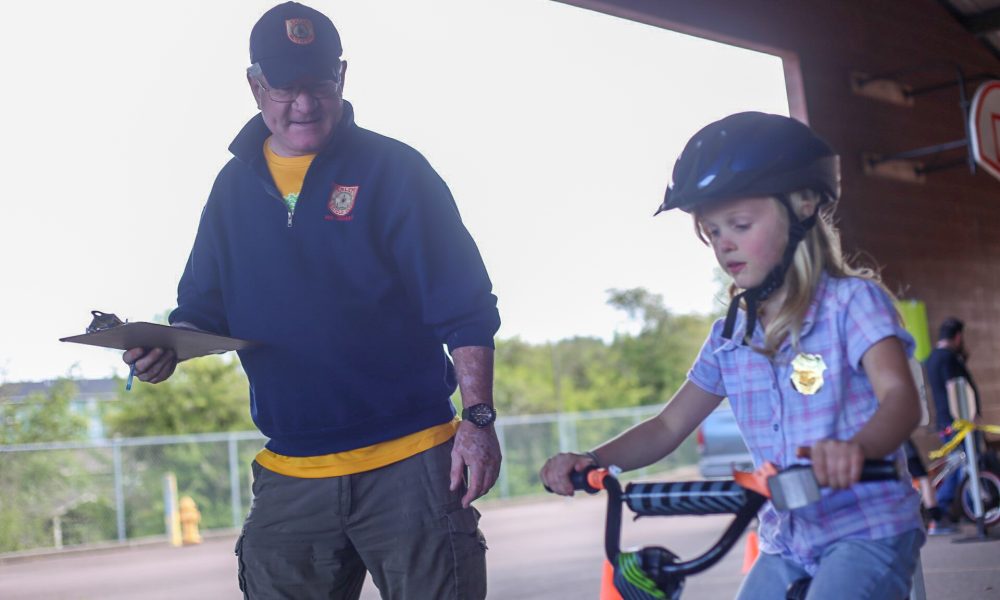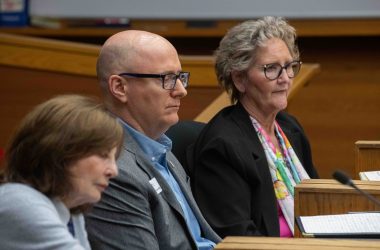 Hersch Sangster teaches a bike safety class at Harritt Elementary School last Friday. A former state worker who bike commuted to work for three decades, he said he wasn’t surprised by a study saying the city won’t add more cyclists in the next 15 years. (Troy Brynelson/Salem Reporter)
Hersch Sangster teaches a bike safety class at Harritt Elementary School last Friday. A former state worker who bike commuted to work for three decades, he said he wasn’t surprised by a study saying the city won’t add more cyclists in the next 15 years. (Troy Brynelson/Salem Reporter)
At Harritt Elementary School on Friday, 65-year-old Hersch Sangster gave the city of Salem a grade — for bike friendliness.
“They’ve gone from an ‘F’ to a ‘C’,” the longtime cyclist said. He said the city is performing better than it used to but is still “mediocre.”
The future may not be much different, according to a new analysis from the city of Salem planning department and Portland-based consulting firm, Fregonese Associates.
The analysis suggests the city likely won’t convince people to trade cars for bikes or sidewalks any time soon. And it arrives at a time when councilors are debating measures to study and reduce the city’s carbon footprint.
The analysis is part of the city’s “Our Salem” project, a years-long overhaul to the city’s master plans for how everything from buildings, streets, parks and sewers can be built for decades to come.
The overhaul started months ago, with city planners and their consultants studying how the city’s current environmental practices, transportation planning, housing and more could look by the year 2035. That glimpse into the future helps them figure out what they want to change, planners say.
The new results suggest Salem’s on a path to even more greenhouse gas emissions.
Planners expect to the city add about 60,000 residents over the next 15 years, meaning more cars and buildings. Land development will also cut down the number of trees in the city, the analysis said.
Meanwhile, the analysis found the percentage of Salem residents biking to work will stay roughly the same — and still beneath city goals — while the percentage of people walking will drop.
The figures say 0.4 percent of Salemites currently bike commute and 3.2 percent go on foot. Biking will remain the same, but pedestrians will dip to 2.3 percent in the coming years.
City goals adopted in 2012 aim for 5 percent of the population to bike and 11 percent to walk by 2030.
City planners note the consultants didn’t survey every resident nor count every commuter, but instead used a model to calculate commutes. The model looked at the city’s other attributes, like land use mix, household size and socioeconomics.
Julie Warncke, the city’s transportation manager, concurred biking and walking aren’t currently popular ways to get around the city.
“We’re trying to provide opportunities, but we do have a hard time measuring,” she said.
The city has invested in bike and pedestrian infrastructure in recent years, she noted. In the last five years, 20 city projects added bike lanes, fixed crosswalks, improved sidewalks and more, she said.
An example is High Street, which now has bike lanes nested between the sidewalk and parking spaces – where parked cars act as a barrier for cyclists.
Another is the Winter-Maple Neighborhood Greenway, a planned multi-million dollar bicycle and pedestrian path running from the Capitol to Salem Parkway. The city installed signs in March and will soon install $50,000 worth of speed bumps, Warncke said.
Those improvements are the kind Sangster hopes to see. Before he retired from the state government, he rode his bike from his Keizer home to the Capitol Mall every morning for more than three decades. He often heard from coworkers they wished to bike commute, too.
“People always say it’s their fear of traffic,” said Sangster, who is also the former president of Salem Bicycle Club. “If you want to get the casual cyclist or walker, it’s got to be friendly.”
Sangster noted there is no panacea to get people on bikes or walking. He said people make numerous considerations in their traveling habits, like parking, access to transportation, or whether they simply feel comfortable doing something besides driving.
“Every problem is multi,” he said. “There is not just one simple thing. The potential to meet those goals is there.”
Those are the realities city workers will contend with in the next phase of “Our Salem.” City Planner Eunice Kim said while the first results show what path the city is on, now the work will look at how the city wants to change.
“There’s a few areas where it seems we’re heading in the right direction, and there are many areas where it’s not clear if we’re heading in the right direction,” she said in an email. “And that’s where (the next phase) comes in.”
Other areas in the analysis include the economy and housing market. The city is poised to offer good job opportunities, wages and overall affordability for residents, the analysis found. It will also add housing using infill development, a city goal.
One inconclusive area included housing affordability, for example. Salem’s housing is getting more expensive but should still be cheaper than Corvallis, Eugene and Portland, according to the data.
Have a tip? Contact reporter Troy Brynelson at 503-575-9930, [email protected] or @TroyWB.
SUBSCRIBE AND DRIVE LOCAL REPORTING — For $10 a month, you get breaking news alerts, emailed newsletters and around-the-clock access to our stories. We depend on subscribers to pay for in-depth, accurate news. Help us grow and get better with your subscription. Sign up HERE.









